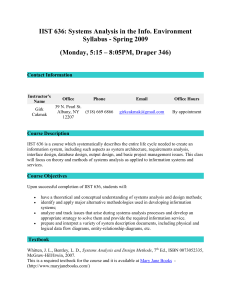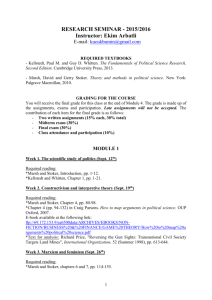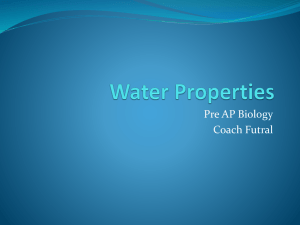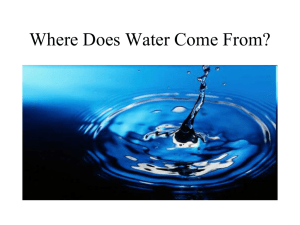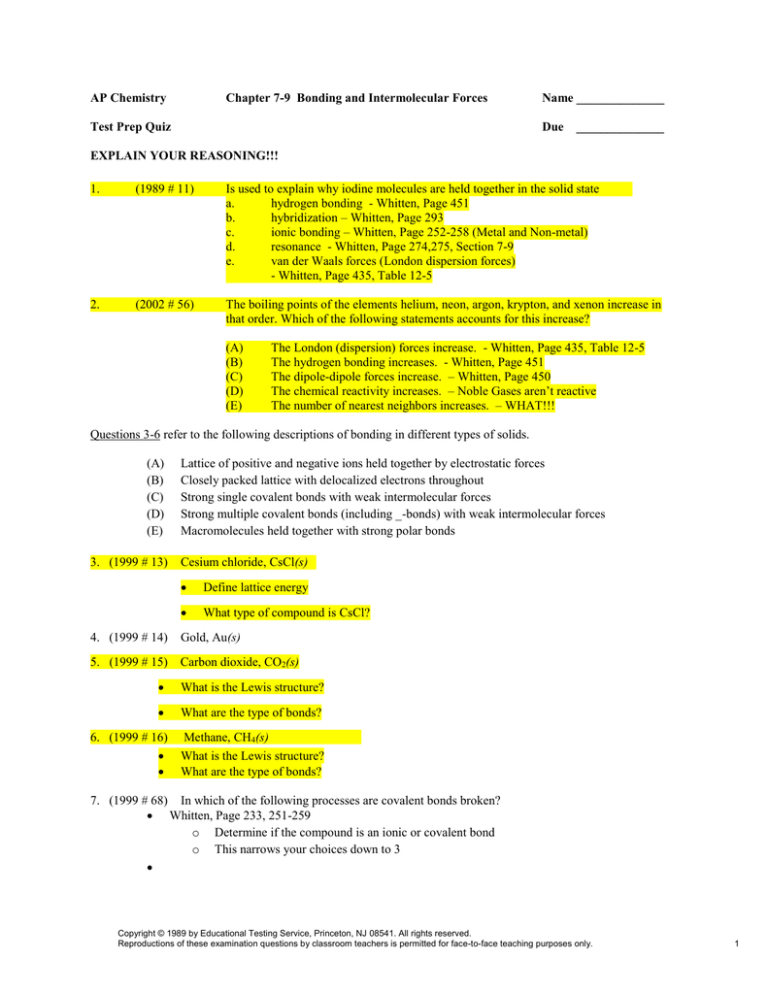
AP Chemistry
Chapter 7-9 Bonding and Intermolecular Forces
Test Prep Quiz
Name ______________
Due
______________
EXPLAIN YOUR REASONING!!!
1.
(1989 # 11)
Is used to explain why iodine molecules are held together in the solid state
a.
hydrogen bonding - Whitten, Page 451
b.
hybridization – Whitten, Page 293
c.
ionic bonding – Whitten, Page 252-258 (Metal and Non-metal)
d.
resonance - Whitten, Page 274,275, Section 7-9
e.
van der Waals forces (London dispersion forces)
- Whitten, Page 435, Table 12-5
2.
(2002 # 56)
The boiling points of the elements helium, neon, argon, krypton, and xenon increase in
that order. Which of the following statements accounts for this increase?
(A)
(B)
(C)
(D)
(E)
The London (dispersion) forces increase. - Whitten, Page 435, Table 12-5
The hydrogen bonding increases. - Whitten, Page 451
The dipole-dipole forces increase. – Whitten, Page 450
The chemical reactivity increases. – Noble Gases aren’t reactive
The number of nearest neighbors increases. – WHAT!!!
Questions 3-6 refer to the following descriptions of bonding in different types of solids.
(A)
(B)
(C)
(D)
(E)
3. (1999 # 13)
Lattice of positive and negative ions held together by electrostatic forces
Closely packed lattice with delocalized electrons throughout
Strong single covalent bonds with weak intermolecular forces
Strong multiple covalent bonds (including _-bonds) with weak intermolecular forces
Macromolecules held together with strong polar bonds
Cesium chloride, CsCl(s)
Define lattice energy
What type of compound is CsCl?
4. (1999 # 14)
Gold, Au(s)
5. (1999 # 15)
Carbon dioxide, CO2(s)
What is the Lewis structure?
What are the type of bonds?
6. (1999 # 16)
Methane, CH4(s)
What is the Lewis structure?
What are the type of bonds?
7. (1999 # 68) In which of the following processes are covalent bonds broken?
Whitten, Page 233, 251-259
o Determine if the compound is an ionic or covalent bond
o This narrows your choices down to 3
Copyright © 1989 by Educational Testing Service, Princeton, NJ 08541. All rights reserved.
Reproductions of these examination questions by classroom teachers is permitted for face-to-face teaching purposes only.
1
(A)
(B)
(C)
(D)
(E)
8. (1989 # 12)
a.
b.
c.
d.
e.
I2(s) I2(g)
CO2(s) CO2(g)
NaCl(s) NaCl(l)
C(diamond) C(g)
Fe(s) Fe(l)
Is used to explain why the boiling point of HF is greater than the boiling point of HBr
hydrogen bonding - Whitten, Page 451
hybridization – Whitten, Page 293
ionic bonding – Whitten, Page 252-258 (Metal and Non-metal)
resonance - Whitten, Page 274,275, Section 7-9
van der Waals forces (London dispersion forces) - Whitten, Page 435, Table 12-5
Questions 9, 10
(A)
(B)
(C)
(D)
(E)
A network solid with covalent bonding
A molecular solid with zero dipole moment
A molecular solid with hydrogen bonding
An ionic solid
A metallic solid
9. (1984 # 8) Solid ethyl alcohol, C2H5OH
Why are answer choices D and E not options?
10. (1984 # 9) Silicon dioxide, SiO2
Why are answer choices D and E not options?
11. (1984 # 18) Hydrogen Halide Normal Boiling Point, ˚C
HF
+19
HCl
–85
HBr
–67
HI
–35
The liquefied hydrogen halides have the normal boiling points given above. The relatively high boiling point
of HF can be correctly explained by which of the following?
(A) HF gas is more ideal.
(B) HF is the strongest acid.
(C) HF molecules have a smaller dipole moment.
(D) HF is much less soluble in water.
(E) HF molecules tend to form hydrogen bonds.
12. (1994 # 32) CH3CH2OH boils at 78oC and CH3OCH3 boils at –24oC, although both compounds have the same
composition. This difference in boiling points may be attributed to a difference in
(A)
molecular mass
(B)
density
(C)
specific heat
(D)
hydrogen bonding
(E)
heat of combustion
Copyright © 1989 by Educational Testing Service, Princeton, NJ 08541. All rights reserved.
Reproductions of these examination questions by classroom teachers is permitted for face-to-face teaching purposes only.
2
13. (1994 # 34)
X.
Y.
Z.
CH3–CH2–CH2–CH2–CH3
CH3–CH2–CH2–CH2–OH
HO–CH2–CH2–CH2–OH
Based on concepts of polarity and hydrogen bonding, which of the following sequences correctly lists the
compounds above in the order of their increasing solubility in water?
(A)
Z<Y<X
(B)
Y<Z<X
(C)
Y<X<Z
(D)
X<Z<Y
(E)
X<Y<Z
14.
(2002 # 67)
Which of the following describes the changes in forces of attraction that occur as H 2O
changes phase from a liquid to a vapor?
(A)
(B)
(C)
(D)
(E)
H—O bonds break as H—H and O—O bonds form.
Hydrogen bonds between H2O molecules are broken.
Covalent bonds between H2O molecules are broken.
Ionic bonds between H+ ions and OH– ions are broken.
Covalent bonds between H+ ions and H2O molecules become more effective.
15. (1984 # 60) Which of the following has a zero dipole moment?
Whitten, Page 232 (Table 6-3), 253
o Electronegativity difference increases Polarity Increases (can only use for a molecule that
has two atoms)
Small (nonexistent) electronegativity difference zero dipole moment
Whitten, Page 277, Example 7-10
o depicts the polarity of molecules where F-Br has a high polarity and F-F has a zero polarity
(dipole moment)
Whitten, Page 262- 267, Section 7-6, Examples 7-1, 7-2, 7-3
o Writing Lewis Structures for HCN, NH3, CN-, and NO2
Whitten, Page 273, Example 7-6
o Limitation D of the Octet Rule
o Write the Lewis formula for PF5
Whitten, Page 290, Table 8-1 (IMPORTANT***)
o The table gives 5 shapes where there is an even distribution of atoms around the central atom
which creates a zero dipole moment
16.. (1994 # 68) Which of the following molecules has a dipole moment of zero?
Whitten, Page 232 (Table 6-3), 253
o Electronegativity difference increases Polarity Increases (can only use for a molecule that
has two atoms)
Small (nonexistent) electronegativity difference zero dipole moment
Whitten, Page 277, Example 7-10
o depicts the polarity of molecules where F-Br has a high polarity and F-F has a zero polarity
(dipole moment)
Whitten, Page 262- 267, Section 7-6, Examples 7-1, 7-2, 7-3
o Writing Lewis Structures for C6H6 (benzene), NO, SO2, NH3, H2S
Higher Melting Smaller Dipole moment (IMPORTANT)
Copyright © 1989 by Educational Testing Service, Princeton, NJ 08541. All rights reserved.
Reproductions of these examination questions by classroom teachers is permitted for face-to-face teaching purposes only.
3
17. (1999 # 40) Of the following molecules, which has the largest dipole moment?
Whitten, Page 232 (Table 6-3), 253
o Electronegativity difference increases Polarity Increases (can only use for a molecule that
has two atoms)
Small (nonexistent) electronegativity difference zero dipole moment
Whitten, Page 277, Example 7-10
o depicts the polarity of molecules where F-Br has a high polarity and F-F has a zero polarity
(dipole moment)
Whitten, Page 262- 267, Section 7-6, Examples 7-1, 7-2, 7-3
o Writing Lewis Structures for CO, CO2, O2, HF, F2
Higher Melting Smaller Dipole moment (IMPORTANT)
18. (2002 # 28) Of the following compounds, which is the most ionic?
Metal and nonmetal
Electronegativity difference, Whitten, Page 253
Copyright © 1989 by Educational Testing Service, Princeton, NJ 08541. All rights reserved.
Reproductions of these examination questions by classroom teachers is permitted for face-to-face teaching purposes only.
4


